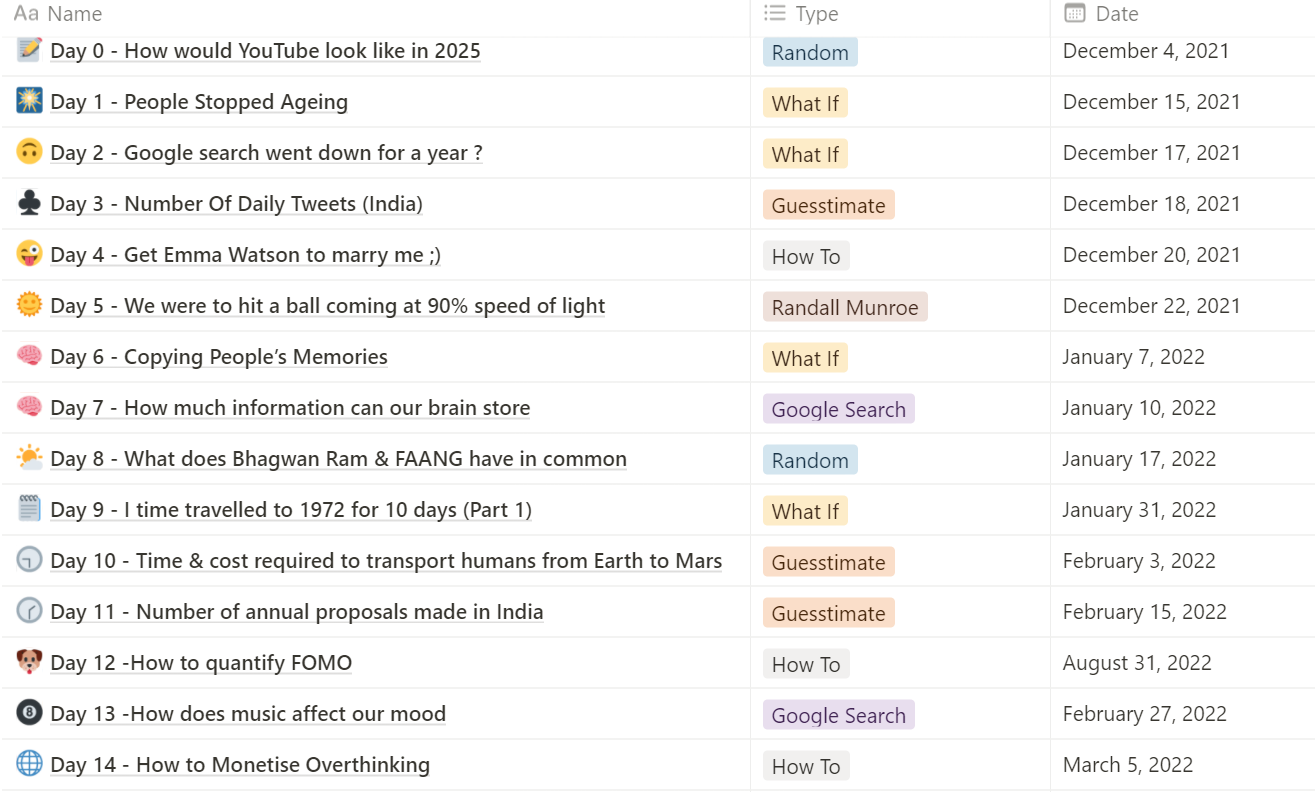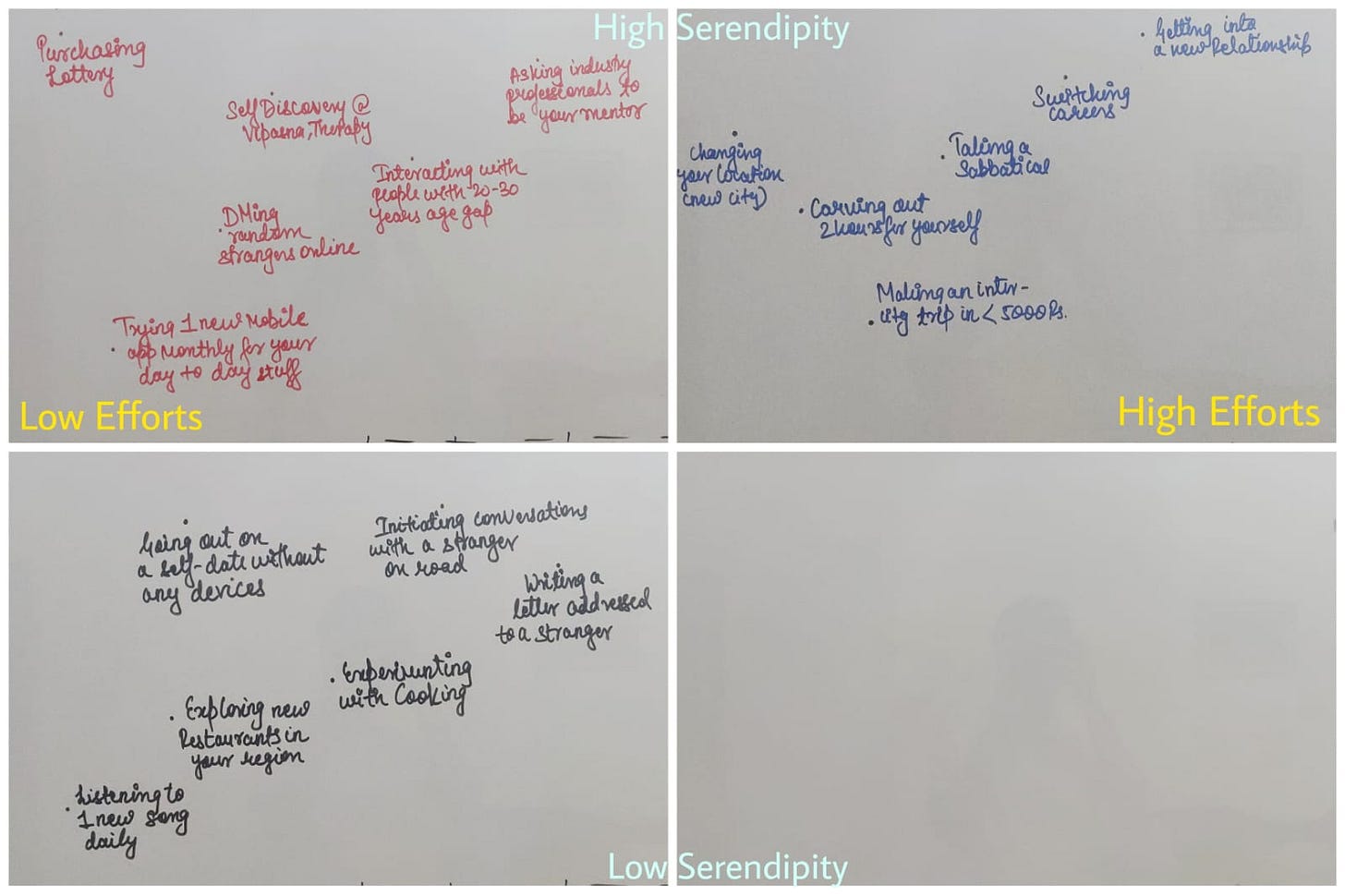#2 Engineering Serendipity
Imagining serendipity in a new way and understanding its core drivers
What is Serendipity
In the summer of 1886, a pharmacist, John Pemberton, wanted to create a syrup to heal headaches, so he hopefully mixed coca leaves and cola nuts, and his assistant accidentally added the mixture to carbonated water, then he tasted it, really liked it. This small accident led to the birth of Coke, a company that has been pivotal over the last 137 years, in creating a multi-billion dollar soft drink empire.
If you are a Kung Fu Panda fan, you would remember this quote that Master Oogway tells Master Shifu
One often meets his destiny on the road one chooses to avoid it
It’s a great line to depict the non-linearity of life, where our actions and the resulting outcomes are linked in a mysterious manner.
Technically, serendipity is nothing but unplanned and unforeseeable great things happening, just in a not-so-intuitive, sometimes even accidental manner.
The intuition or realization of serendipity could be short-term (immediately recognizable) vs long-term (can take months/years to acknowledge)
It also means that if you make the time horizon extremely long/infinity, everything could hypothetically fall under the bucket of serendipity
Some of my biggest life-changing experiences happened in an extremely non-intentional way, where I did not immediately realize the benefits and positive long-term outcomes of something that had happened!
Levers of Serendipity
I have been a maths student in school, and one of the topics I always liked was that of Functions, to the extent that I sometimes think of a lot of things in life in the form of functions.
So I thought it would be fun to think of different variables that a function f(x) of Serendipity would depend upon
1.) S = f (age)
Higher age of an individual, means they have had more experience and exposure (situations, people, content, ideas), and therefore a much enhanced and mature ability to connect the dots, process circumstances, create and acknowledge favourable positive outcomes
Control: no control wrt the pace at which we age → 0% control (unless you jump onboard a space-ship which is travelling at near speed of light, that would just age you slowly, so technically your rate of serendipity would reduce further :P)
2.) S = f (content)
I think this is by far, one of the most critical and high-frequency variable, as we are all consuming content 24X7 literally. It’s intuitive to imagine that a big contributor to our thoughts and ideas is the content we consume, therefore it becomes super important to tweak and monitor it, periodically.
There are broad 3-4 forms of content that we are consuming - text (books, articles, newspapers), audio (music, radio, podcasts), and video (short form & long form). The majority of the content that we consume, can roughly be bucketed across different verticals - entertainment, productivity, work, career-related, psychology and philosophy, science and technology, business, personal growth, health and happiness, life, relationships etc
Honestly, it’s quite difficult for me to say which type of content leads to higher serendipity, however, over the last 2 years I have come to realise that it’s always helpful to keep an eye out for different types of content, something that you would otherwise not consume (because it’s in different domain/range of what you generally consume), and getting exposed to such newer forms of content, at times can trigger a chain of thoughts, or spark some ideas.
For e.g. exploring the New/Trending section on YouTube nudges me to watch a whole plethora of videos, which don’t come on my recommendation/home page. I follow dozens of blogs on Substack, yet I go to the Discover section to just explore any new writers. Here are a few people and blogs I like to read/watch/listen to, once in a while, to get a different dose of content - Wait But Why, Nicky Case, Paras Chopra, Visa, Young Money, Farnam Street, Every.To, Nick Bostrom.
Control: extremely controllable and highly democratized lever → one has access to almost 90% of online content, barring that 10% of the content which is paid and not freely accessible
Back in 2021, I stumbled across this book titled “What If” by scientist Randall Munroe, and that nudged me to try and adopt this habit of thinking and approaching random things, and try and build my thinking muscle. This substack piece is one such example.
3.) S = f (money)
More wealth gives you the capability to try different things, travel to newer places, have more experiences, meet more influential people (most probably with higher than average serendipity quotient) and increase your overall exposure across different verticals, thereby enabling you to engineer smart luck
Most importantly, money gives you the power to be able to implement and execute your ideas, and high amounts of the capital provide you access to a lot of elite powerful people and exclusive stuff (content, people, travel, experiences), which otherwise the majority of the people don’t have access to.
Control: complicated to create an immediate delta, over short intervals (unless you are a crypto/options trader XD) → semi-controllable/slowly changes with time
4.) S = f (people)
Turns out this phrase - “you are the average of the 5 people you surround yourself with” is after all true, as one of the biggest influencing factors for the way we think, we operate, and the opportunities we get, is the kind of people that we choose to spend time with. Having access to more people to interact with is definitely helpful in creating serendipity, however, I have always felt that it’s the quality of people and the depth of conversations, that matter far more than just the number of people.
I think for us to engineer serendipity, it’s important to keep creating and nurturing new connections every once in a while - by reaching out to strangers on LinkedIn/Twitter/Instagram, being part of online/offline communities, and exploring interest clubs and groups. It’s understandable that we can’t meet new people all the time, therefore most of us have an inner circle of 1-5 people whom we interact with most frequently. I feel engaging with those people regularly, in varied kinds of deep discussions can be very meaningful.
This would definitely result in us learning about how different people operate, that’'s how we get new ideas, get inspired, and are encouraged to do something similar in our lives. Small unforeseeable nudges from people, at times, can be a critical driver and can go a long way in enabling us to change our direction of efforts and adopt a newer perspective towards how we function.
Control: its a bit difficult to change the immediate inner circle completely, that might require breaking old friendships and forging new ones, change of location, switching jobs, entering into a relationship etc, but there is a higher probability to try and find newer people either in your locality or online, to connect with → semi controllable
5.) S = f (free time & free mind)
Fortunately / unfortunately, some of our best ideas emerge, when we are in the bathroom (shower thoughts), purely because there is nothing else to divert our minds, it becomes super important to keep taking breaks every now and then, to approach life and circumstances with a new perspective.
Free time is one of the biggest luxuries one can have, it lets you think openly and freely, and more importantly, it gives us unhindered time to just explore and play with things, as long as you want to, without having a timer going at the back of your head. All of us have 24 hours, you need 7-8 hours of sleep, followed by additional 2-3 hours to freshen up and have meals, and maybe a 30 min - 1-hour travel (work/personal), thereby leaving you with 12 hours of operational time at hand.
However, it isn’t the number of free hours that we want to increase, it’s the free mind space that we want to optimise. For e.g. someone who is extremely overworked is battling a personal crisis, or has a lot going on in their minds - even if they find 6-12 hours of free time, there is a higher chance that they would still keep thinking about work or focusing towards solving the problem at hand or cooling themselves off, and lesser chance (less doesn’t mean 0 :p) that they would be able to take out time to explore something new.
I remember back in 2021, when I wasn’t working for about 9 months, and that surprisingly enabled me to explore a myriad of new things - Notion, Twitter, Substack, which have immensely shaped the way I see and document, and manage my life.
Control: technically yes, but everyone doesn’t have full control of their time, due to the various obligations which end up consuming your time (school, college, work, family, travel) → semi controllable
In the graph - I feel for the same X number of free hours, there would ideally be a range of serendipity happening, depending on their age and what they are engaged in (physically, emotionally, intellectually), for the rest of their day
6.) S = f (attitude & efforts)
One can imagine two people, in identical situations (could be good or bad), yet their long-term outcomes could be poles apart, purely basis the outlook with which they see the circumstances, the way they perceive and imagine the unforeseeable future situations, which determines their actions and thereby drives their outcomes
Control: it seems 100% controllable, but attitude and efforts get built over years and are a function of a plethora of things - your childhood, past experiences, and what things worked for you, therefore a shift is possible but it might be a slow process which needs a lot of conscious efforts.
Inculcating an experimentation mindset becomes quintessential, and approaching things with a sense of playfulness and as a new experience rather than always seeking and predicting how the end outcome would look like. This reminds me of a long Twitter thread that Visa wrote, on just doing an activity 100 times, without thinking of the results and then noticing how you would have improved in the entire process

There is a serendipity formula, that I read in a book titled “The Seductive Illusion of Hard work” by Utkarsh Amitabh, which talked about increasing the Luck Surface Area (LSA) = D (doing a lot of things) X T (telling a lot of people). It primarily shared that we ought to do and create a lot of interesting experiences and then be able to communicate and share those things with more people, which could create word-of-mouth/network effects and can eventually result in you creating smart luck.
It boils down to saying yes to a lot of new things and new experiences, despite not knowing pre-hand how they are going to pan out, or even going against your intuition and still doing things. I started working towards creating a list of things that I would do, purely to experiment, tackle some difficult situations, and explore new sides of myself.
Serendipity Graph
This is a 2X2 matrix, mapping serendipity vs input (efforts, time, money etc), however, I wasn't able to find any high-effort activity resulting in low serendipity.
That’s it for this post folks
I will try to publish Part 2, sometime in late February, and also will try to be mindful to build consistency and start publishing these content pieces a bit more regularly.
See you later!










